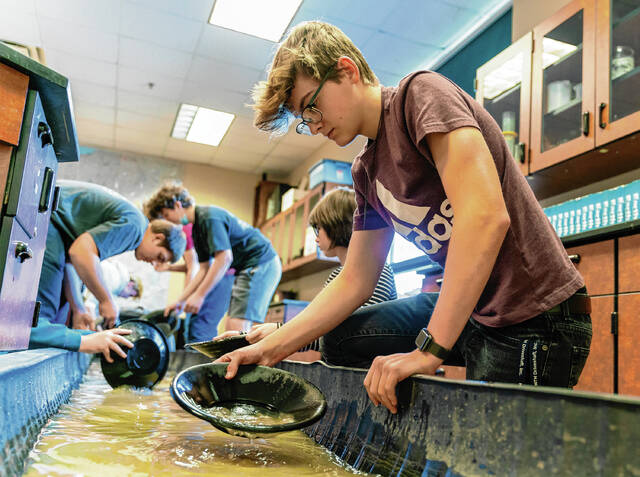A muddy stream laid across the floor of a classroom attracted students to capitalize on the high school’s own gold rush.
The stream was part of Kevin Leineweber’s Earth science class. The Greenwood Community High School teacher wanted to make the geology unit more exciting and hands-on for students who might otherwise be bored by the subject matter, he said.
With funding help from a Greenwood Education Foundation grant, he purchased a Culvert pipe with a two-foot diameter, cut off the top and laid the 30-foot half-pipe across one side of his classroom, filled it with sand, $700 worth of gold flakes and used a pond pump to fill it with flowing water.
Students used black pans to collect the sandy mixture and separate out the gold flakes, which they could take home. Though students can learn about the California Gold Rush of 1849 in textbooks, the experience of finding real gold they could take home recreated some of the excitement of the time, Leineweber said.
“It’s my own idea. The topic can be boring and there are books and videos, but I wanted to have a hands-on experience,” he said. “I started Googling last semester, ‘how do you build a river in a classroom?’ There wasn’t anything out there. I started brainstorming. If I was to build a river, how would I build it? I kept brainstorming and building the idea until I had something I thought would work.”
The fun, hands-on experiments aren’t limited to learning about the gold rush. When students learned about hot and cold fronts, for example, they mixed heated soda candy with cold water, causing it to compress, said Isaiah Hopkins, a sophomore.
“It’s not just that he’s a good teacher, he gives us the time we need to understand what he’s talking about, and the experiments he comes up with are fun,” Hopkins said. “It’s fun because he doesn’t bother you when you’re conversing about what you’re doing, and he gives you time to do the experiment.”
Lexi Salas, also a sophomore, swirled water in the pan and spotted a fleck of gold amongst the sand. With the gold more dense than the sand, it sank to the bottom, while the sand flowed with the water over the edge of the pan.
“I thought it was going to be more of a boring learning class, but it’s more interactive and really fun. It helped me learn stuff I wouldn’t,” Salas said. “We’re learning about minerals and rocks, which is really fun. We have done the hurricane game to learn about weather. We had partners and had to make decisions such as go to work or not depending on if the hurricane was coming. If you had more points, you won. If the hurricane hit and you were not prepared, you lost.”
After 25 years in education, Leineweber said he’s getting more creative with his lesson plans as he approaches retirement, but there are still some things that are beyond his reach.
“The last quarter of the year, we study astronomy,” he said. “That includes the Earth, moon, Solar System, stars. I don’t have a magic school bus that can take me through the Solar System.”
Still, it’s his goal to give his students memorable experiences, Leineweber said.
“Looking at my own experience in high school, I grew up in Chicago, sat at a desk and memorized information. I was not a big fan of that,” he said. “I’m at the end of my teaching career. I’m looking forward to retiring in five years. I want to go out on top of my game and be the best teacher I can be.”





